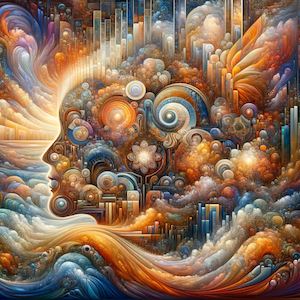Research Statement: AI’s Pivotal Role in the Arts and Enhancing Visual Literacy
Introduction
In the dynamic intersection of Artificial Intelligence (AI) and the arts, we stand at a threshold where the boundaries of creativity, originality, and artistic expression are continuously being redefined. My research, inspired by the innovative curriculum of “DTC 338: AI in the Arts,” delves into the transformative role of AI in creative fields and its profound impact on visual literacy. This exploration is not just about harnessing technology to create art; it’s an in-depth inquiry into how AI technologies, particularly generative AI and machine learning, augment, extend, and challenge traditional notions of artistry, creativity, and the educational methodologies used to foster visual literacy.
Objectives
The primary goal of my research is twofold: first, to analyze and articulate the role of AI in the fine arts, with a focus on design, image generation, and analysis; and second, to explore how AI can enhance visual literacy skills, critical thinking, and cultural and contextual understanding of visual media. By integrating AI and machine learning (ML) technologies, this research aims to contribute to educational innovation, offering new pathways for engaging with and understanding the arts.
AI’s Role in the Fine Arts
In the realm of fine arts, AI acts as both a tool and a collaborator, offering artists new mediums and methodologies for creation. From algorithmic art to AI-assisted design, the integration of AI technologies has led to novel forms of expression and the emergence of digital aesthetics that challenge traditional artistic paradigms. My research investigates how AI algorithms interpret, generate, and transform visual content, thus contributing to the discourse on originality, authorship, and the essence of creativity. This includes examining projects where AI collaborates with artists to produce works that are reflective of a shared human-machine creativity, thereby redefining the artist’s role in an AI-driven process.
Enhancing Visual Literacy through AI
Visual literacy, the ability to interpret, negotiate, and make meaning from information presented in the form of an image, is increasingly crucial in the digital age. My research leverages AI and ML technologies to develop a Visual Literacy Education Chatbot, aimed at enhancing users’ skills in critically analyzing and interpreting visual media. This involves creating interactive learning modules that use image analysis scenarios, integrating multimedia to cater to diverse learning styles, and implementing personalized learning paths. By doing so, this project addresses the need for educational tools that prepare users to effectively navigate and understand the visually-rich landscape of digital media.
Philosophical Dimensions: Sentience, Intelligence, and Artistic Ability
A significant aspect of my research is the philosophical exploration of sentience, intelligence, and artistic ability, particularly how these concepts intertwine with AI’s capabilities in the arts. This inquiry delves into questions about what constitutes creativity and whether AI can possess or mimic artistic sensibility. By examining the processes through which AI generates art, this research engages with broader debates on the nature of intelligence and consciousness, questioning whether AI can be considered a sentient or intelligent entity in the context of artistic creation.
Methodology
Utilizing a qualitative research approach, this study involves case studies of AI in various artistic projects, interviews with artists and technologists, and the development and testing of the Visual Literacy Education Chatbot. Through this multi-faceted methodology, the research aims to provide a comprehensive analysis of AI’s impact on the arts and visual literacy, supported by empirical evidence and theoretical frameworks.
Expected Outcomes
The anticipated outcomes of this research include a deeper understanding of AI’s role in redefining artistry and creativity, enhanced methods for teaching and learning visual literacy in the digital age, and contributions to the fields of educational technology and AI ethics. This research expects to demonstrate that AI, when integrated thoughtfully with artistic and educational practices, can significantly enrich both the creative process and the development of critical skills necessary for engaging with visual media.
Conclusion
The intersection of AI and the arts represents a fertile ground for exploring new forms of expression, challenging traditional notions of creativity, and developing innovative educational tools. My research, situated within this dynamic field, seeks to shed light on the complex relationships between AI, art, and visual literacy, offering insights into how technology can enhance and transform artistic expression and education. As we move forward, the integration of AI in the arts and education not only opens new avenues for creativity but also prompts us to reconsider our understanding of intelligence, sentience, and the essence of artistic ability. Through this exploration, we can begin to envision a future where AI and human creativity coalesce, leading to unprecedented forms of artistic expression and a deeper appreciation of the visual world around us.


